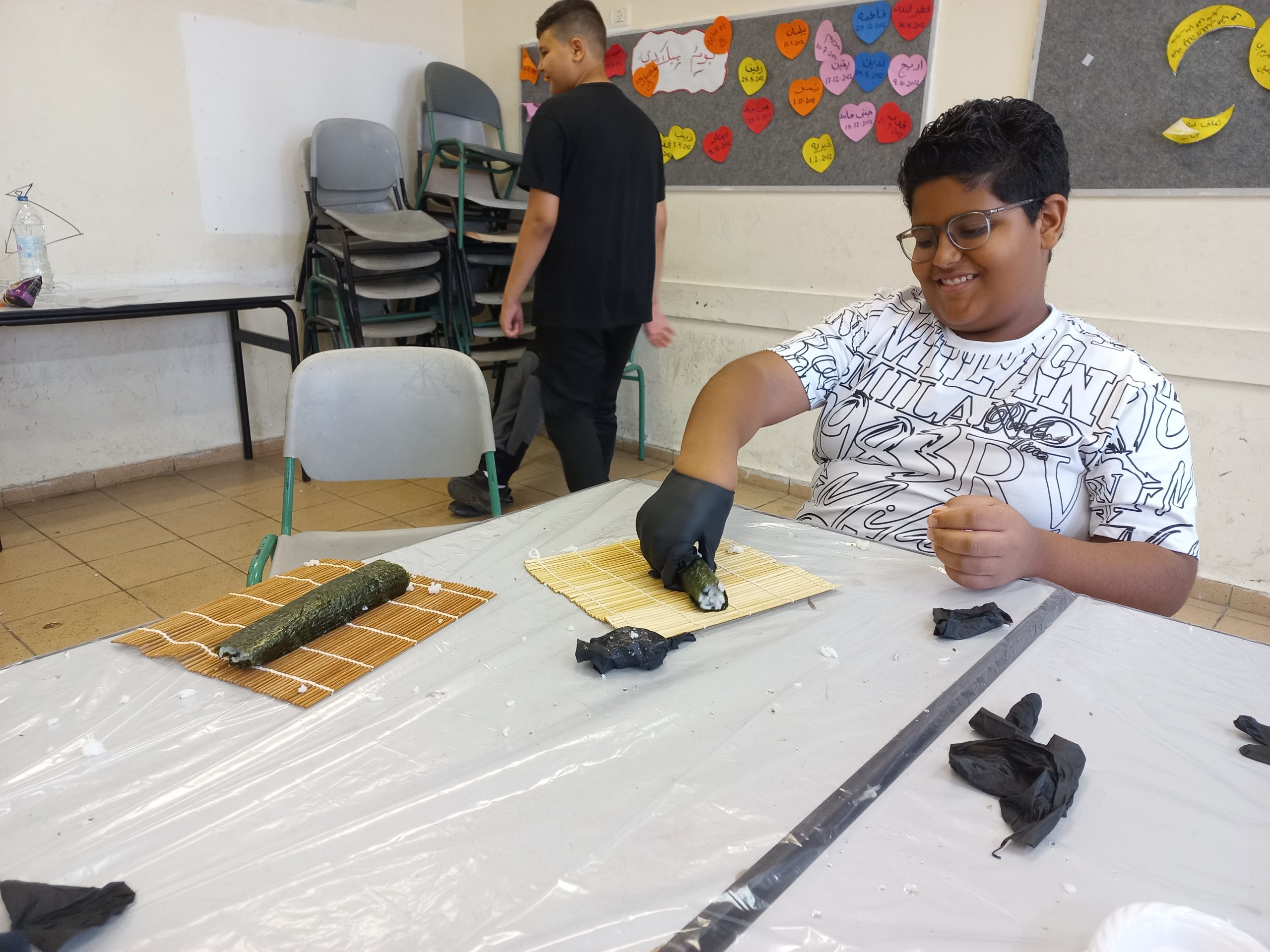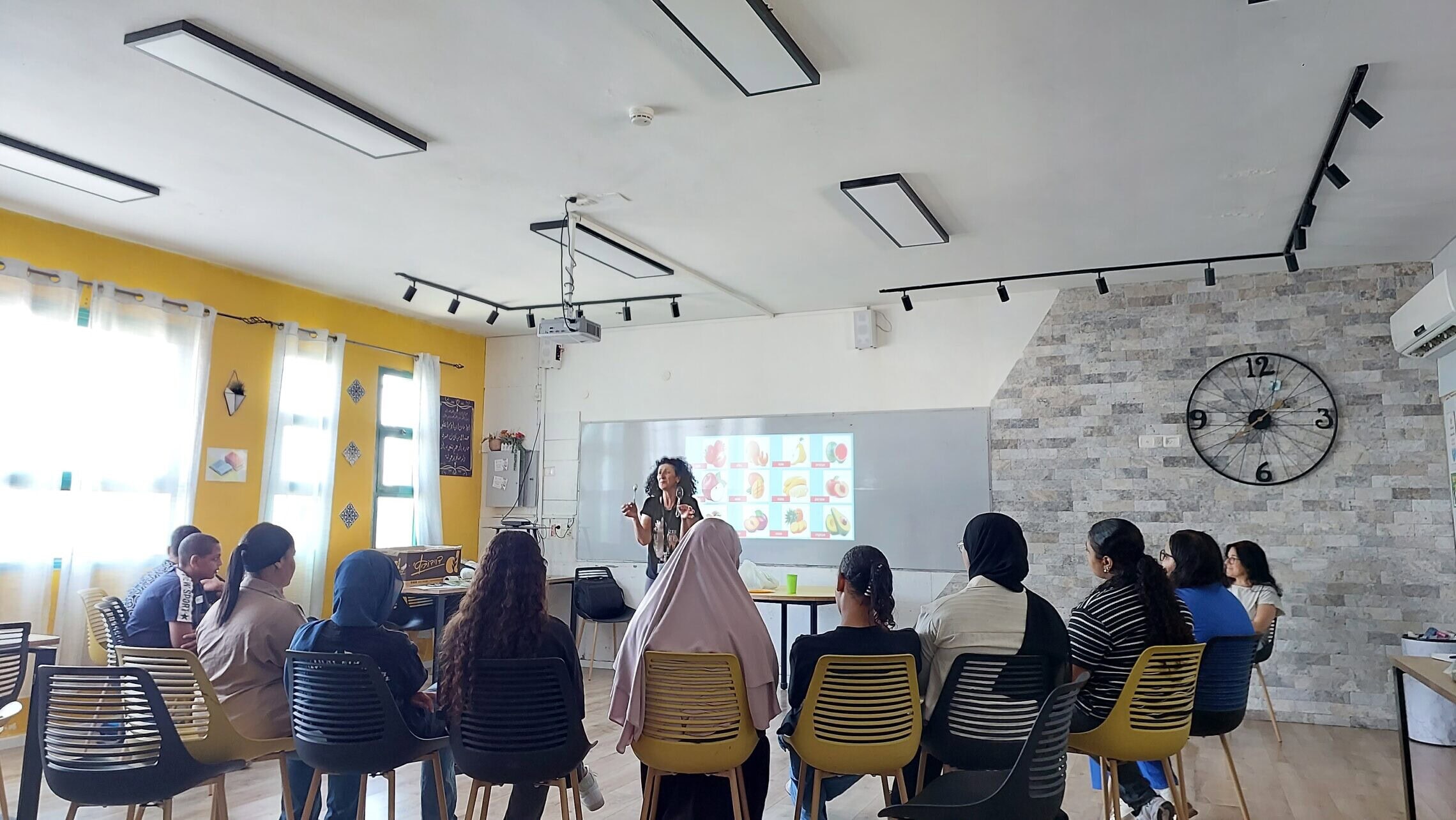“Who knows what fruits are white?” the teacher asks. There is silence, and she throws a paper ball to Mohammad. He answers: “Banana, pineapple, pear, apple.” The teacher fires a follow-up question: “What fruit is not round but long?” She throws the ball to Naim, who immediately answers: “Banana.”
“Did Father bring this from the market?” asks the teacher in a nearby classroom, and the children answer according to the fruit or vegetable she has in her hand. In a third classroom, a variation on a similar theme takes place: the teacher holds up a grater and asks, “What do you grate with it?” – “Jazar… um… carrots… cheese,” one of the students replies. And so on, with a fork, a plate, a cutting board, and other kitchen utensils.
It’s 10:00 a.m., and the young teenagers, from grades 7 to 9, sitting in a semicircle, seem alert and attentive to the lesson with their teachers, who speak to them only in Hebrew. Their phones have been collected in a bag in the teachers’ room, to reduce distractions. Some of the girls are wearing headscarves, some are not. Shyness – or lack thereof – is distributed relatively evenly between the boys and girls, all of whom barely speak Hebrew.

After recess, the classrooms are much noisier. Loud banging on the tables can be heard from the hallway. They’re not losing concentration – just pounding biscuits in a bag to make chocolate balls. In another classroom, the children are mashing rice on seaweed and rolling it into sushi. The girls, and some of the boys, are holding their noses because of the smell of the seaweed and can’t participate in the activity.
“Does this smell? You’re by the sea and this smell bothers you?” the teacher wonders, and rightly so. We are at the “Al-Salam” middle school in Jisr a-Zarqa. These children have seen, breathed, and smelled the sea since they were born, in the small village between Caesarea and Ma’agan Michael. The school is on its northern edge, and from here you can see the fish ponds of Ma’agan Michael and the Taninim Stream, over which stood the original bridge with the blue water that gave the settlement its name.
At the end of the day, they sat down to eat fruit skewers, vegetable salad, sushi, and chocolate balls – and talk. About 50 teenagers in grades 7 to 9 are attending the Hebrew camp this week, which lasts five full days, free of charge and without screening. Classes with fun activities to alleviate any dismay at studying during summer vacation. The week also includes days of visiting Kibbutz Ein Shemer and Givat Haviva, which operates the camp as part of the “Shared Language” project.
The first camp this holiday was held in J’daida-Makher, and more were supposed to take place – but the war with Iran thwarted the coordination and final closure. A Hebrew youth camp for high school students is expected to run this coming winter. The teachers, who function here as a sort of camp counselors, work during the year as full-time Hebrew teachers in Arab schools.
The children who arrived at the camp are at beginner-level Hebrew. The teachers in front of them are probably the first adult Jew they have met in person in their lives, and over the course of the day you can see a personal and emotional connection beginning to form – with a good chance that they will remember this encounter for years. At a time of mutual suspicion and hostility, that is no small feat.
The teachers are talented and receive support for teaching Hebrew at Givat Haviva, but beyond leadership and pedagogical knowledge, they were apparently born with an inner belief that allows them to keep these groups attentive and interested – even during the summer holidays. They are not afraid to leave the classroom for a moment while the children are cutting salad and mashing the ingredients on the table, and it goes smoothly.
Children are children, and it is impossible to tell that we are in one of the poorest communities in the country. In Jisr a-Zarqa there are a little over 3,500 students, about 34% of whom graduate from high school with matriculation, and about half of whom are accepted to universities.
The residents work mainly outside the community, within which there is almost no interface with the Hebrew language. It takes some effort for children to answer the question of when they last spoke the country’s official national language. Some answered that they spoke a little with their parents, or at the mall in Or Akiva, and that they know Eden Ben Zaken and a few other songs from YouTube and… that’s about it.
The settlement looks rather neglected, the narrow roads needing urgent attention. A shiny new residential project faces the beach, where the first Jewish residents have moved in. A hostel that opened a few years ago in the town center, where Hebrew classes were also held has turned into a grocery store. On Monday this week, the restaurants on the beach and in the center of town were closed, and I finally found a delicious falafel stand by the roadside, whose owner came from home to prepare it.
In a cafe in the center of town, a young man said that he learned Hebrew when he went to work with his father. His friends study at universities in Israel, the West Bank, Jordan, and other countries.
“The children of Nazareth are not the children of J’daida, and both are very different from those we meet here today in Jisr a-Zarqa. Arab society is a spectrum with differences between populations, just like Jewish society, and we need to make adjustments,” says Itay Cohen, 41, from Ramat David, who is a camp instructor here and during the year teaches in Nazareth and J’daida.
“At school my instruction is more frontal, while here the content is conveyed in a limited way – mainly the aim is to get them to speak as much as possible. The emphasis is on spoken language. Many times they make a switch in their heads and discover that they know. The use of language is less here in the village because Arabic is more accessible, and as soon as they practice Hebrew – they discover that they know it. Yesterday was introductions, today it’s food, and tomorrow – sports day.
“We learned words and soon we’ll cook, cut a banana on a cutting board, say and apply the words. It’s more useful than reading in a book, like we were taught. When you speak the same language – you can understand each other, talk about difficulties or just small talk. It really works, and my presence here also gives exposure to another culture – and vice versa,” he added.
Hebrew is a significant obstacle for students from Arab society, for whom it is a second language – or often a third, after English, which is also a required academic language. In schools they learn grammar and hardly speak, and that is the barrier this camp is trying to break.
“A lot of it is about confidence and practice, and once they practice and experience success, they realize that it’s not about being smart. I encourage them to make mistakes, and when the fear of making a mistake takes over or when someone laughs, I ask: ‘Why are you laughing?’ You don’t have to be afraid of the language – you can simply say: ‘Excuse me, how do you say such and such?'” says teacher Gali Spitzer, who normally teaches Hebrew in schools in Umm al-Fahm and Barta’a.
“Our fear also lessens– they are not interfacing with us in everyday life. The Ministry of Education wants instant results, but for me what’s important is to instill confidence, and I work through experiential and rational sense. I have a background in Arabic, and it is important for me to understand their culture, but I try to communicate only in Hebrew. I do not teach in my language because it is better, but because it is the national language – and they need it to get by,” she adds.
Givat Haviva, which runs the camp, located at the edge of Wadi Ara, is one of the largest organizations for a shared society in Israel. About 30 of its trained teachers, who receive close supervision, teach Hebrew in Arab schools. Givat Haviva also teaches Arabic on campus, operates an art gallery, and a few years ago established an international school where Jewish and Arab students study together.
“One goal is to teach the language – as much as they can absorb – and reduce their reluctance, so that they will see that it’s possible. We don’t expect someone who couldn’t answer what grade they are in on the first day, beyond counting fingers, to have a fluent conversation on Thursday. But we do expect them to feel confident in saying a few words they have acquired and creating a basic conversation,” says Dikla Tomer Kaial, Director of the Education Department at Givat Haviva.
“The second goal is the meeting with the Jewish teacher. For most of them, this is their first encounter with a person from Jewish society – who smiles at them, asks how they are, and by the second or third day they are hugging. It’s a lifelong encounter, super meaningful. The experience of cutting fruit into shapes seems banal, but for them it’s also creative. As experiential as it may be, we’re not promising swimming pools and Superland – but they came.
“We are entering our 11th year of teaching Hebrew in Arab schools, and this is the second year of the summer camp with the two returning communities – in J’daida and Jizr. The war caught us at a bad time, because we also wanted to open a summer camp for youth, but in the winter there will be a youth camp for grades 10-11, focusing on academia and employment.”
“The secret of the magic here is not a particular activity, but the personal relationship – and that is what excites them the most. We teach Hebrew not out of a desire for Arab society to progress towards Jewishness, and we also have an Arabic institute. It is important to us that there is a connection and an emotional bond, and we understand that language is a bridge.”





